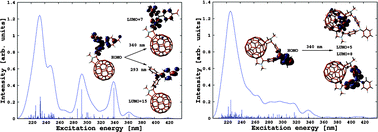Linear and nonlinear optical properties of triphenylamine-functionalized C60: insights from theory and experiment†
Abstract
In the present study we report on the linear and nonlinear optical properties of C60–

Maintenance work is planned for Wednesday 1st May 2024 from 9:00am to 11:00am (BST).
During this time, the performance of our website may be affected - searches may run slowly and some pages may be temporarily unavailable. If this happens, please try refreshing your web browser or try waiting two to three minutes before trying again.
We apologise for any inconvenience this might cause and thank you for your patience.
* Corresponding authors
a
Theoretical Chemistry Group, Institute of Physical and Theoretical Chemistry, Wrocław University of Technology, Wyb. Wyspiańskiego 27, 50-370 Wrocław, Poland
E-mail:
robert.zalesny@pwr.wroc.pl
b
Department of Material Sciences, Faculty of Engineering Sciences, Kyushu University, Kasuga, Fukuoka 816-8580, Japan
E-mail:
loboda@mm.kyushu-u.ac.jp
c
Department of Physics, University of Patras, Greece, Also at Institute of Chemical Engineering and High Temperature Chemical Processes (ICEHT), Foundation for Research and Technology-Hellas (FORTH), P.O. Box 1414, 26504 Patras, Greece
E-mail:
couris@iceht.forth.gr
d
Theoretical and Physical Chemistry Institute, National Hellenic Research Foundation, 48 Vass. Constantinou Avenue, 11635 Athens, Greece
E-mail:
tagmatar@eie.gr
e
Institute of Organic and Pharmaceutical Chemistry, National Hellenic Research Foundation, 48 Vass. Constandinou Avenue11635 Athens, Greece
E-mail:
mpapad@eie.gr
In the present study we report on the linear and nonlinear optical properties of C60–

 Please wait while we load your content...
Something went wrong. Try again?
Please wait while we load your content...
Something went wrong. Try again?
R. Zaleśny, O. Loboda, K. Iliopoulos, G. Chatzikyriakos, S. Couris, G. Rotas, N. Tagmatarchis, A. Avramopoulos and M. G. Papadopoulos, Phys. Chem. Chem. Phys., 2010, 12, 373 DOI: 10.1039/B917825B
To request permission to reproduce material from this article, please go to the Copyright Clearance Center request page.
If you are an author contributing to an RSC publication, you do not need to request permission provided correct acknowledgement is given.
If you are the author of this article, you do not need to request permission to reproduce figures and diagrams provided correct acknowledgement is given. If you want to reproduce the whole article in a third-party publication (excluding your thesis/dissertation for which permission is not required) please go to the Copyright Clearance Center request page.
Read more about how to correctly acknowledge RSC content.
 Fetching data from CrossRef.
Fetching data from CrossRef.
This may take some time to load.
Loading related content
